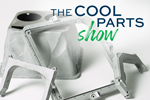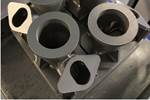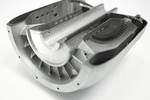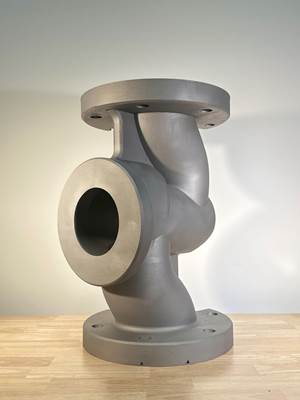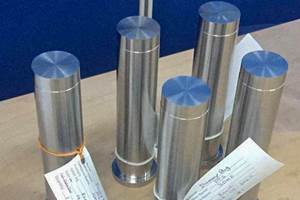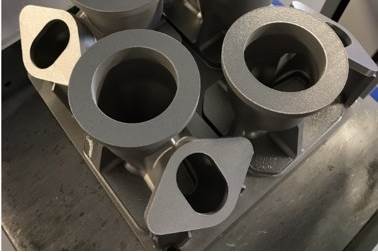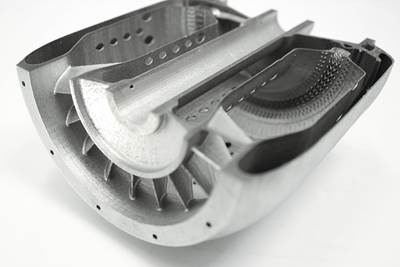The Manufacturing Demonstration Facility at Oak Ridge National Laboratory worked with Solar Turbines to prove the effectiveness of turbine blades made through additive manufacturing. A typical turbine used in power generation includes hundreds of turbine blades, and Oak Ridge researchers 3D printed nearly 300 blades for this testing.
The blades were made via electron beam melting (EBM) to the same design as existing turbine blades, as well as in the same material, Inconel 738, meaning the researchers had to master EBM for this unusual alloy. Proving that AM can reliably produce today’s blades is just the start, because the promise is that turbine blades made via additive will incorporate complex internal cooling channels allowing turbines to run hotter for greater efficiency. In this episode, learn about the manufacturing challenges that were overcome, as well as the engineering possibilities of 3D printed turbine blades. | This episode of The Cool Parts Show brought to you by Carpenter Additive
The Cool Parts Show is a video series from Additive Manufacturing Media that explores the what, how and why of unusual 3D printed parts. Watch more here.
Have a cool part to share? Email us.
Related Resources
- Oak Ridge National Laboratory Manufacturing Demonstration Facility
- Solar Turbines
- Electron beam melting technology provider GE Additive
- EBM applications related to Mars, implants and meerkats.
Transcript
Peter Zelinski
Can 3D printing make more powerful turbines? We'll find out on this episode of The Cool Parts Show.
Stephanie Hendrixson
This episode of The Cool Parts Show is brought to you by Carpenter Additive. The company's PowderLife solution is a combination of hardware and software technologies designed to help AM users manage their metal powders. Stay tuned after the episode for more on how this system works.
Peter Zelinski
I'm Pete.
Stephanie Hendrixson
I'm Stephanie.
Peter Zelinski
Welcome to The Cool Parts Show. This is our show all about unique, amazing, transformative, disruptive, power generating 3D printed parts.
Stephanie Hendrixson
Okay, power generating, you have my attention. What are the parts today?
Meet the Cool Part
Peter Zelinski
Okay the parts today are turbine blades. Turbine system for power generation basically a big machine using hot pressurized gas to spin a rotating shaft. Inside of a turbine there are lots of these blades, maybe hundreds of them, maybe this size maybe bigger. Today these blades are made through casting and machining but there is huge promise huge potential in getting to make them through additive manufacturing instead. But first additive has to prove itself.
Stephanie Hendrixson
And since this is The Cool Parts Show all about cool 3D printed parts I'm guessing that these blades here have something to do with that, with additive proving itself.
Peter Zelinski
So these blades, they were manufactured for Solar Turbines, turbine manufacturer, and Solar Turbines agreed to run 3D printed turbine blades through their paces within the company's testbed for evaluating stuff like this. The blades were made through additive manufacturing by Oak Ridge National Laboratory in Tennessee at their Manufacturing Demonstration Facility which is this complex where Oak Ridge helps companies explore, adopt, embrace advanced manufacturing technologies. So yeah, additive had to prove itself and you look at these from a distance and you wouldn't at a glance necessarily know they were 3D printed. So the first step for 3D printing is just to demonstrate it can reliably make the turbine blades as they are today, as they're designed today. So the geometric freedoms of additive manufacturing off the table for now, just make the blades as they are. And the material freedom of additive manufacturing, no, for now prove that we can make it out of the material these blades are made out of right now. So 3D printing proving itself and so this case, what we're seeing here is kind of additive manufacturing with one hand tied behind its back.
Material for 3D Printed Turbine Blades
Stephanie Hendrixson
Okay. So, 3D printing with one hand behind its back I kind of like that imagery. So, the design is the same as conventional blades and you said the material is as well. What is the material here?
Peter Zelinski
Inconel 738, a nickel-based alloy, the 738 variety of that is one we don't hear about all that much. Within casting it is kind of a legacy material, but it is the material that these turbine blades are made out of.
The 3D Printing Process for Turbine Blades
Stephanie Hendrixson
okay. So legacy casting material, existing blade design, but let's talk 3D printing. How are these made?
Peter Zelinski
Electron beam melting. Electron beam melting is a powder bed fusion process that operates at high temperature. It was chosen because of the material, Inconel 738, which is a metal that is prone to stress cracking and EBM electron beam melting offers some power and capability to control against that kind of cracking in the process. And that was the first significant challenge of producing these turbine blades is assuring a complete 3D printing process in which that kind of cracking never occurred. So let me introduce you to Mike Kirka. He is a research material scientist at Oak Ridge. And he's been involved with this project all the way through.
Mike Kirka
From the origins of this program with Solar was a desire to demonstrate that we could use 3D printing and that it was mature enough in terms of materials and technology to be able to rapidly prototype new turbine blade designs. So this is more for the engine design process and evaluation. The challenge that's put forth in this is, can we demonstrate not just one printing of one turbine blade but entire blade sets while also certifying and qualifying these materials and geometry, that they're safe to enter an engine without having the ability to disintegrate there and cause severe damage. For this project we use the electron beam melting process over laser powder bed. And this was due to a number of different factors, one being the ability to manipulate the heat source, the vacuum environment, to keep impurities out and the heated powder bed of about 1000 Celsius that in the Arcam electron beam melting process, which is not typically found in those of laser powder bed processes. Part of where this becomes important is Inconel 738, which was used in this program, is similar to other casting materials used for turbine blades that are very defect prone, crack just due to thermal stresses on cooling from the liquid to the solid. And using this ability to have rapid control over the heat source, the electron beam, we were able to suppress a lot of the different thermal gradients that would happen in the parts that would potentially lead to cracking and even them out such that we could process the blades defect free.
Why 3D Print Turbine Blades?
Stephanie Hendrixson
Okay, so I'm not a material scientist, but this material sounds like a real pain. So let's just take a step back, why do they want to do this? Why do they want to 3D print these blades out of this material when there are other ways of making them that are potentially easier?
Peter Zelinski
Yeah. And ways that are working now. So like, Yeah, why 3D print this? And like, why does 3D printing have to prove itself? Right? And the answer, and it's an important answer, the answer is power, power, and specifically more efficient generation of power. Because we could get to turbines that generate more output for the same size of equipment, just more overall efficiency. And the way to get to that is with heat, with turbines that run hotter. And the way to enable turbines to run hotter is to cool these blades more effectively. And the way to do that is to get more sophisticated, internal cooling passages within these blades. And I know your attention perked up when I said that, because that's what additive manufacturing can do. It's really good at at capturing complex internal geometry, complicated passages and channels built right into the solid form. So that's what's at stake here, and that's what's on the table is potentially better performing turbines.
Mike Kirka
So 3D printing is known for its ability of flexibility design. And the same holds true for turbine blade applications where you can open up new design paradigms for more efficient cooling schemes or enhanced cooling that would allow turbine blades in the hot section of the engine run much hotter, while being able to be cooled. And this would have multiple impacts from essentially the energy efficiency of the engines themselves, because they can run hotter, to also potentially more resilient components so they would have longer service lives.
Challenges of 3D Printing Turbine Blades
Stephanie Hendrixson
So it sounds like there's a lot of potential opportunity here and Oak Ridge is on its way to figuring out at least the 3D printing side of this. Are there other challenges that they're working through?
Peter Zelinski
So yeah, this was a big project. So something on the order of 300, turbine blades were 3D printed, I think maybe the precise number was 288. They were built in sets of four, four in one build volume. And for a long time there it was build after build after build after build, producing these turbine blades to get enough to do a really comprehensive test. And then once they were done with all of that 3D printing, then came the machining and the machining took just as long because there were challenges there as well.
Mike Kirka
So machining is actually a large part of the 3D printing process. In the case of these turbine blades, similar to as they're cast today, there are critical features such as the fir tree shrouds, if they're shrouded, cooling channels and also the pressure sides of the turbine blades that must have critical tolerances down to micron type precision, because these are mating surfaces that will come into contact with other portions of the engine once they come up to temperature. In the case of the 3D printed turbine blades, machining them was difficult due to a combination of the 3D printing process, you have heard shrinkage or geometric distortions that happen that can be predicted to a degree but for one off type parts it's a bit more difficult, but then also sort of the lack of thought on the pre design of datums or how are you going to fixture the part and then what are the measurements going to go off for finishing the whole part. Especially so in a turbine blade where there's very few perpendicular parallel type surfaces.
Peter Zelinski
So you asked about challenges and then that's one of them. Machining is a significant part of producing these components as well. Right now this phase of the test, the aim was to prove that 3D printing can do the job. That it can make sufficiently strong, high performing turbine blades. And that was proven, that was demonstrated. But in the future, this idea moves into production and the design freedom of additive manufacturing can facilitate that production as well. In addition to getting all of these complex internal passages that can realize some of the promise, design elements in additive can also set up the process so that that machining can be a lot easier to do next time around. And maybe that is locating features that are helpful for machining or maybe it's clamping features that help hold it in just the right way for the machine tool, but part of the design freedom and design possibility will be to create an additive manufacturing process that is higher performing as well.
The Cool Part Recap
Stephanie Hendrixson
Alright, so I think I got this. These are turbine blades that are designed to go into a large power generation turbine. They were 3D printed at the Manufacturing Demonstration Facility at Oak Ridge in collaboration with Solar Turbines. And the idea here was to get 3D printed blades into a power turbine to see if the technology can work in that application. So they use the same existing design for these blades, they use the same legacy casting material, Inconel 738. And the material dictated the 3D printing method here. They used electron beam melting because Inconel is prone to cracking and that was the best process to try and print them and avoid that cracking. But the machining turned out to be an equal challenge along with the 3D printing, and they had to figure out various things like how to locate these parts in the machine tool. But the real advantage here, if we are able to 3D print blades like this is the internal geometry. Being able to incorporate better, more advanced, more efficient cooling channels into these blades would allow the turbines to run hotter, to produce energy more efficiently. You get more power out of the same equipment that we already have.
Peter Zelinski
Yeah, totally so that'll do it. So thank you for watching. Thanks for watching The Cool Parts Show. Check out our earlier episodes, including all of our other electron beam melting, EBM, episodes at TheCoolPartsShow.com.
Stephanie Hendrixson
If you have a cool part you'd like to tell us about whether it's literally cooled or not, you can email us at CoolParts@AdditiveManufacturing.media.
Peter Zelinski
If you like the show, leave us a comment, leave us a like and be sure to subscribe.
Stephanie Hendrixson
Thanks for watching.
Stephanie Hendrixson
Thanks again to our sponsor Carpenter Additive. In addition to supplying metal powders, the company also offers services, software and hardware to help AM users manage their powder. One example is the PowderLife system, a combination of cloud based tracking software with hardware designed to make powder handling easier. Two key components are the powder life hopper and the automated docking station. Luke Boyer, manager of PowderLife applications and Andrew Holliday, Applications Engineer explain how the system works.
Luke Boyer
So today, when a user of additive manufacturing is receiving powder, they oftentimes receive it in either 5, 10, 15, maybe a 20 kilo bottle, but they're receiving pallets of them and you're receiving 10, 20, 50 or hundreds of these bottles. The user has to look and segregate and store them appropriately so the bottles don't get mixed up and it requires a lot of lifting and moving and labor.
Andrew Holliday
The components of PowderLife are all based around making powder management systems on the added manufacturing shop floor easier to use for the operator, cleaner, as well as more traceable. Three of those basic parts of PowderLife are our PowderLife Hoppers or our storage containers for powder. The second would be an automated docking system that allows material to be pushed in and out of machines with no human contact. The third would be our PowerLife Online software system that allows you to trace this powder as it goes through your shop floor.
Luke Boyer
The hardware and the software together just helps really streamline that and improve the final users experience and let them concentrate on going from design to the part itself. It takes the headache of powder management out of the equation for them.
Related Content
Sintavia Developing Additive Manufacturing Facility for US Navy
Sintavia is collaborating with Bechtel Plant Machinery to develop a dedicated additive manufacturing facility in support of the United States Naval Nuclear Propulsion Program.
Read MoreVideo: 5" Diameter Navy Artillery Rounds Made Through Robot Directed Energy Deposition (DED) Instead of Forging
Big Metal Additive conceives additive manufacturing production factory making hundreds of Navy projectile housings per day.
Read More3D Printed Seal for Geothermal Power: The Cool Parts Show #73
Plugging a hole is a complex challenge when it’s a well for geothermal power. Additive manufacturing produces a shape-changing stainless steel seal for high-temperature applications deep underground.
Read MoreConocoPhillips Sees Oil and Gas Supply Chain Opportunity With Additive Manufacturing
Production of parts when needed and where needed can respond to the oil and gas sector’s multibillion-dollar challenge of holding parts in inventory. The supply chain benefit will justify additive even before the design freedoms are explored.
Read MoreRead Next
3D Printed Parts on the Mars Perseverance Rover: The Cool Parts Show #23
The Perseverance parts made through additive manufacturing are extreme examples of lightweighting. We have replicas of the 3D printed parts that were sent to Mars.
Read MoreGE Aviation Switches Four Existing Cast Parts to Metal 3D Printing
GE engineers say additive manufacturing can compete with casting as its improved productivity lowers cost and slashes development time.
Read MoreThis 3D Printed Turbine Replaced 61 Parts With 1: Here Is What That Means
Additive manufacturing makes possible a radical microturbine that increases power-to-weight ratio, reduces cost and extends time between overhaul.
Read More


